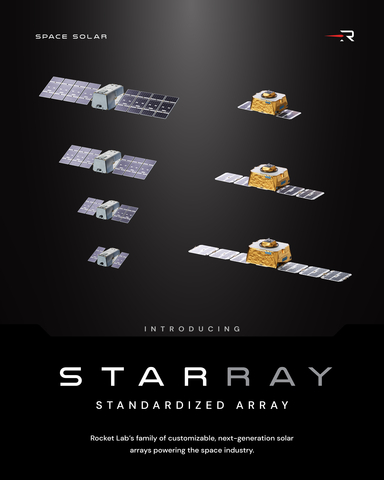Rocket Lab Expands Satellite Solutions with Customizable Solar Arrays
Rocket Lab (NASDAQ: RKLB) has unveiled its new Standardized Array (STARRAY) family of customizable solar arrays at the 40th Space Symposium. The STARRAY system can be tailored to meet satellite power requirements from 100 watts to over 2,000 watts, utilizing up to four panels per wing with radiation-hardened quadruple junction solar cells.
As the world's only vertically integrated solar array manufacturer, Rocket Lab produces everything from solar cells to fully integrated arrays. Their solar solutions currently power over 1,100 satellites in orbit, including critical missions like NASA's Artemis lunar explorations, the James Webb Space Telescope, and OneWeb's GEN1 broadband constellation.
The company aims to provide mission-specific customization with shorter lead times and reduced costs through pre-engineered solar array configurations, leveraging their 20+ years of flight heritage in space-grade solar solutions.
Rocket Lab (NASDAQ: RKLB) ha presentato la sua nuova famiglia di array solari personalizzabili Standardized Array (STARRAY) durante il 40° Space Symposium. Il sistema STARRAY può essere adattato per soddisfare le esigenze di potenza dei satelliti, da 100 watt a oltre 2.000 watt, utilizzando fino a quattro pannelli per ala con celle solari a giunzione quadrupla rinforzate contro le radiazioni.
Essendo l'unico produttore di array solari verticalmente integrato al mondo, Rocket Lab produce tutto, dalle celle solari agli array completamente integrati. Le loro soluzioni solari alimentano attualmente oltre 1.100 satelliti in orbita, comprese missioni critiche come le esplorazioni lunari Artemis della NASA, il Telescopio Spaziale James Webb e la costellazione di banda larga GEN1 di OneWeb.
L'azienda mira a fornire personalizzazioni specifiche per la missione con tempi di consegna più brevi e costi ridotti attraverso configurazioni di array solari pre-ingegnerizzate, sfruttando i loro oltre 20 anni di esperienza nel settore delle soluzioni solari per applicazioni spaziali.
Rocket Lab (NASDAQ: RKLB) ha presentado su nueva familia de arrays solares personalizables Standardized Array (STARRAY) en el 40° Space Symposium. El sistema STARRAY puede adaptarse para satisfacer los requisitos de potencia de los satélites, desde 100 vatios hasta más de 2.000 vatios, utilizando hasta cuatro paneles por ala con celdas solares de unión cuádruple resistentes a la radiación.
Como el único fabricante de arrays solares verticalmente integrado en el mundo, Rocket Lab produce todo, desde celdas solares hasta arrays completamente integrados. Sus soluciones solares actualmente alimentan más de 1.100 satélites en órbita, incluidas misiones críticas como las exploraciones lunares Artemis de la NASA, el Telescopio Espacial James Webb y la constelación de banda ancha GEN1 de OneWeb.
La empresa tiene como objetivo proporcionar personalización específica para la misión con tiempos de entrega más cortos y costos reducidos a través de configuraciones de arrays solares preingenierizadas, aprovechando sus más de 20 años de experiencia en soluciones solares para aplicaciones espaciales.
로켓랩 (NASDAQ: RKLB)은 제40회 우주 심포지엄에서 맞춤형 태양광 패널의 새로운 표준화 배열 (STARRAY) 가족을 공개했습니다. STARRAY 시스템은 100와트에서 2,000와트를 초과하는 위성 전력 요구 사항을 충족하도록 조정할 수 있으며, 방사선 내성이 있는 사중 접합 태양 전지로 날개당 최대 4개의 패널을 사용할 수 있습니다.
세계 유일의 수직 통합 태양광 배열 제조업체인 로켓랩은 태양 전지에서 완전 통합 배열에 이르기까지 모든 것을 생산합니다. 그들의 태양광 솔루션은 현재 NASA의 아르테미스 달 탐사, 제임스 웹 우주 망원경, 원웹의 GEN1 광대역 별자리와 같은 중요한 임무를 포함하여 1,100개 이상의 위성을 지구 궤도로 운영하고 있습니다.
회사는 20년 이상의 우주 등급 태양광 솔루션 비행 유산을 활용하여 사전 엔지니어링된 태양광 배열 구성을 통해 짧은 리드 타임과 비용 절감을 통해 임무별 맞춤화를 제공하는 것을 목표로 하고 있습니다.
Rocket Lab (NASDAQ: RKLB) a dévoilé sa nouvelle famille de panneaux solaires personnalisables Standardized Array (STARRAY) lors du 40e Space Symposium. Le système STARRAY peut être adapté pour répondre aux besoins en énergie des satellites, allant de 100 watts à plus de 2 000 watts, en utilisant jusqu'à quatre panneaux par aile avec des cellules solaires à jonction quadruple renforcées contre les radiations.
En tant que seul fabricant d'arrays solaires verticalement intégré au monde, Rocket Lab produit tout, des cellules solaires aux arrays entièrement intégrés. Leurs solutions solaires alimentent actuellement plus de 1 100 satellites en orbite, y compris des missions critiques telles que les explorations lunaires Artemis de la NASA, le télescope spatial James Webb et la constellation de bande large GEN1 de OneWeb.
L'entreprise vise à fournir des personnalisations spécifiques à la mission avec des délais de livraison plus courts et des coûts réduits grâce à des configurations d'arrays solaires préconçues, tirant parti de ses plus de 20 ans d'expérience dans les solutions solaires de qualité spatiale.
Rocket Lab (NASDAQ: RKLB) hat auf dem 40. Space Symposium seine neue Familie von anpassbaren Solarmodulen Standardized Array (STARRAY) vorgestellt. Das STARRAY-System kann an die Leistungsanforderungen von Satelliten angepasst werden, von 100 Watt bis über 2.000 Watt, wobei bis zu vier Paneele pro Flügel mit strahlungsbeständigen Vierfach-Junction-Solarzellen verwendet werden können.
Als weltweit einziger vertikal integrierter Hersteller von Solarmodulen produziert Rocket Lab alles, von Solarzellen bis hin zu vollständig integrierten Arrays. Ihre Solarlösungen versorgen derzeit über 1.100 Satelliten im Orbit, einschließlich kritischer Missionen wie den Artemis-Mondexplorationen der NASA, dem James-Webb-Weltraumteleskop und dem GEN1-Breitbandkonstellation von OneWeb.
Das Unternehmen zielt darauf ab, missionsspezifische Anpassungen mit kürzeren Lieferzeiten und reduzierten Kosten durch vorgefertigte Solarmodulkonfigurationen anzubieten und dabei auf über 20 Jahre Erfahrung in der Raumfahrttechnologie zurückzugreifen.
- Vertical integration in solar array manufacturing provides competitive advantage
- Established market presence with 1,100+ satellites using their solar technology
- Proven track record with major space missions including NASA and commercial clients
- Product flexibility covering wide power range (100W to 2000W+) reduces engineering costs
- None.
Insights
Rocket Lab's introduction of its STARRAY solar array product line represents a strategic expansion of the company's space systems business, building on their vertical integration strengths. This move allows them to capitalize on their existing manufacturing capabilities while addressing a critical satellite component market with substantial growth potential.
The company's claim of being the world's only vertically integrated solar array manufacturer provides a significant competitive advantage, potentially enabling the faster lead times and cost efficiencies mentioned in the announcement. The modular approach – supporting power needs from 100W to over 2,000W – allows Rocket Lab to serve everything from small satellites to larger spacecraft with standardized components.
Most notably, Rocket Lab already has substantial flight heritage in this domain, with over 1,100 satellites currently powered by their solar products. Their technology has supported high-profile missions including NASA's Artemis lunar program and the James Webb Space Telescope, demonstrating proven reliability in the most demanding applications.
This product expansion aligns with industry trends toward modular, configurable satellite components and enhances Rocket Lab's position as an end-to-end space solutions provider. By reducing non-recurring engineering costs while maintaining customization options, the STARRAY line addresses key customer pain points in the commercial satellite manufacturing process, potentially accelerating Rocket Lab's penetration of the satellite components market beyond their current customer base.

Credit: Rocket Lab
STARRAY can be tailored to meet satellite power requirements ranging from approximately 100 watts to greater than 2,000 watts, by incorporating up to four panels per wing and utilizing Rocket Lab’s highest efficiency, radiation-hardened quadruple junction solar cells. This enables unparalleled flexibility from a pre-engineered solution and optimal performance with limited investment in non-recurring engineering.
Rocket Lab boasts the world’s only vertically integrated solar array manufacturing capability, including high-volume production of solar cells, solar cell assemblies or CICs, solar panel substrates, completed solar panels and fully integrated solar arrays.
“Our objective is to offer the industry mission–specific customization with short lead times and lower costs,” said Brad Clevenger, Vice President of Space Systems at Rocket Lab. “Customers can choose from a range of pre-engineered solar array configurations to meet the needs of their application while leveraging the flight-proven reliability, performance, and speed of Rocket Lab’s vertically-integrated manufacturing.”
With over 20 years of flight-heritage, Rocket Lab’s space-grade solar solutions have powered critical civil, national security and commercial space programs such as the missile awareness systems and interplanetary science missions, the James Webb Space Telescope, Space Telescope, NASA’s Artemis lunar explorations, Ingenuity Mars Helicopter, and the Mars Insight Lander. Rocket Lab's technology also serves a booming commercial satellite market, such as powering the OneWeb’s GEN1 broadband internet LEO satellite constellation. Currently, over 1,100 satellites in-orbit are powered by Rocket Lab’s solar products.
Learn more about Rocket Lab’s Space Solar solutions: Solar Solutions | Rocket Lab
+ About Rocket Lab
Founded in 2006, Rocket Lab is an end-to-end space company with an established track record of mission success. We deliver reliable launch services, satellite manufacture, spacecraft components, and on-orbit management solutions that make it faster, easier, and more affordable to access space. Headquartered in
+ Forward Looking Statements
This press release contains forward-looking statements within the meaning of the Private Securities Litigation Reform Act of 1995. We intend such forward-looking statements to be covered by the safe harbor provisions for forward-looking statements contained in Section 27A of the Securities Act of 1933, as amended (the “Securities Act”) and Section 21E of the Securities Exchange Act of 1934, as amended (the “Exchange Act”). All statements contained in this press release other than statements of historical fact, including, without limitation, statements regarding our launch and space systems operations, launch schedule and window, safe and repeatable access to space, Neutron development, operational expansion and business strategy are forward-looking statements. The words “believe,” “may,” “will,” “estimate,” “potential,” “continue,” “anticipate,” “intend,” “expect,” “strategy,” “future,” “could,” “would,” “project,” “plan,” “target,” and similar expressions are intended to identify forward-looking statements, though not all forward-looking statements use these words or expressions. These statements are neither promises nor guarantees, but involve known and unknown risks, uncertainties and other important factors that may cause our actual results, performance or achievements to be materially different from any future results, performance or achievements expressed or implied by the forward-looking statements, including but not limited to the factors, risks and uncertainties included in our Annual Report on Form 10-K for the fiscal year ended December 31, 2024, as such factors may be updated from time to time in our other filings with the Securities and Exchange Commission (the “SEC”), accessible on the SEC’s website at www.sec.gov and the Investor Relations section of our website at www.rocketlabusa.com, which could cause our actual results to differ materially from those indicated by the forward-looking statements made in this press release. Any such forward-looking statements represent management’s estimates as of the date of this press release. While we may elect to update such forward-looking statements at some point in the future, we disclaim any obligation to do so, even if subsequent events cause our views to change.
View source version on businesswire.com: https://www.businesswire.com/news/home/20250408812937/en/
+ Rocket Lab Media Contact
Lindsay McLaurin
media@rocketlabusa.com
Source: Rocket Lab USA, Inc.







